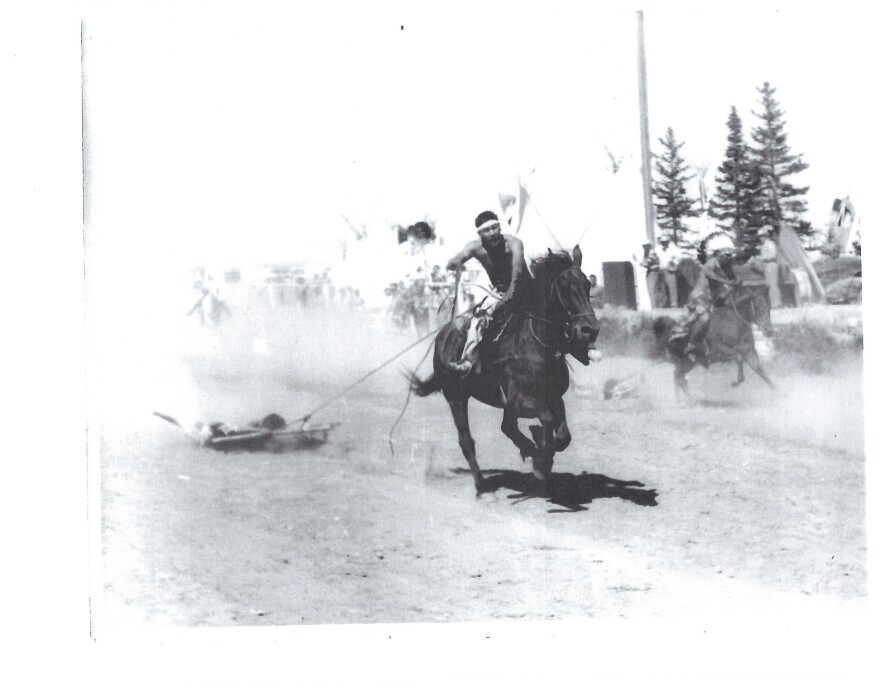The town of Sheridan is about to have a new landmark – and it speaks to a not-so-distant history that many might not know about. From 1953 to 1984, All American Indian Days brought thousands to the Sheridan Fairgrounds every year in an effort to eliminate racial discrimination.
The event started after a sixteen-year-old Crow girl named Lucy Yellowmule was selected as the Sheridan WYO Rodeo Queen in 1951. Yellowmule and a city businessman named Howard Sinclair started a campaign to address racist signs that said “No Indians or Dogs Allowed” in local storefronts. Over time, their efforts and the efforts of other Native and non-Native community members grew into All American Indian Days.
Throughout the years, the event celebrated Native American culture, arts, and games. Highlights of the gathering were the selection of Miss Indian America and the Outstanding Indian of the Year Award, which recognized work that benefited the well-being of Native communities. The event also created an opportunity for different tribes from across the country and Canada to come together to share ideas in forums centered around health and government.
Sarah Johnson Luther is Diné and was crowned Miss Indian America at All American Indian Days in 1967. For her, one of the most moving parts of the event was a Sunday worship service with Native and non-Native clergy from all over the country, leading hymns sung in both English and different Native languages.
"All of that was just so moving…so many tribes and tribal members were there, and then you also had the different denominations that came – joining voices, just joining hearts to celebrate a Sunday morning service,” she said.
Luther came up with the idea for the memorial after realizing that there were no landmarks or signs visibly telling the story of the event in Sheridan.
“I kept looking around for something to jump out at me and say, ‘All American Indian Days was held here so many years ago,’” she said. “And I was disappointed and very sad, because I saw the energy that the people that I knew who lived there poured into this event, year after year.”
In 2019, Luther connected with Vivian Arviso (Diné), who was crowned Miss Indian America in 1960. Together, they collaborated with William Patton, a relative of one of the organizers for the event, and formed the Honoring Project to bring awareness to the history and legacy of All American Indian Days.
Arviso said that the story of the event offers evidence of how a small town can bring people together in a big, impactful way.
“People can commit to make things better and live side by side with their neighbors, regardless of the color of their skin and whether they live on a reservation or in town,” she said.
Luther said she hopes the actions of the original event founders inspire people to take action to create more welcoming and inclusive communities in the present.
“They had to step out of their comfort zone and say, ‘Yes, I want to help address racism right here in my town, I want to see if I can make a difference,’” she said.
The centerpiece of the new memorial is a twelve-foot tall limestone sculpture by Assiniboine and Gros Ventre artist Jon Decelles. It’s called Mitakuye Oyasin, a Lakota phrase which translates to “We Are All Related” and which Decelles said refers to the interconnectedness between all things – plants, animals, people, and the stars.
For Decelles, the roughly 17,000 pound sculpture is a call for racial harmony in what can often feel like a fractured world.
“I did an abstract form presenting our Sacred Hoop to the world, representing harmony, unity, and the four directions and many different things to different Plains tribes,” he said. “I also did more research and the hoop has been used throughout history in many cultures as a symbol of unity and harmony. I thought, ‘How perfect is that?’”
Decelles fell in love with stone carving while studying at the Institute of American Indian Art in Santa Fe, New Mexico. The artist refers to the stone as Tunka-shila, which means “grandfather stone” in Lakota. For Decelles, the permanence of working with stone – once you chip, there’s no going back – lends itself to a highly collaborative creative process.
“If something strange happens, I usually go with the flow and let the stone guide me to whatever it wants to be,” he said. “When I start sculptures, I have a conversation with the stone – I ask ‘What shall we become this time?’”
Decelles was chosen to create the art piece for the memorial after a national search initiated by The Honoring Project. He carved Mitakuye Oyasin in Las Vegas, Nevada, where he now lives, and said the process was very physically and emotionally intense at times.
“I prayed daily as I carved on the piece, talking to the stone and my relations all around me. Many times my prayers turned to tears for having this special opportunity to speak to the world,” Decelles said.
Panels at the base of Mitakuye Oyasin tell the story of All American Indian Days, and the names of many who participated in the event are engraved into bricks and four memorial benches surrounding the sculpture.
The official dedication for the memorial will take place on Indigenous Peoples’ Day, October 9th, at 10am at the Rotary Park in the Sheridan Historic Railroad District. During the dedication, the memorial will be blessed by Tom Yellowtail (Crow) and Wallace Bearchum (Northern Cheyenne), then the Honoring Project will transfer ownership of the memorial as a gift to the City of Sheridan. The celebration is free and open to all.







